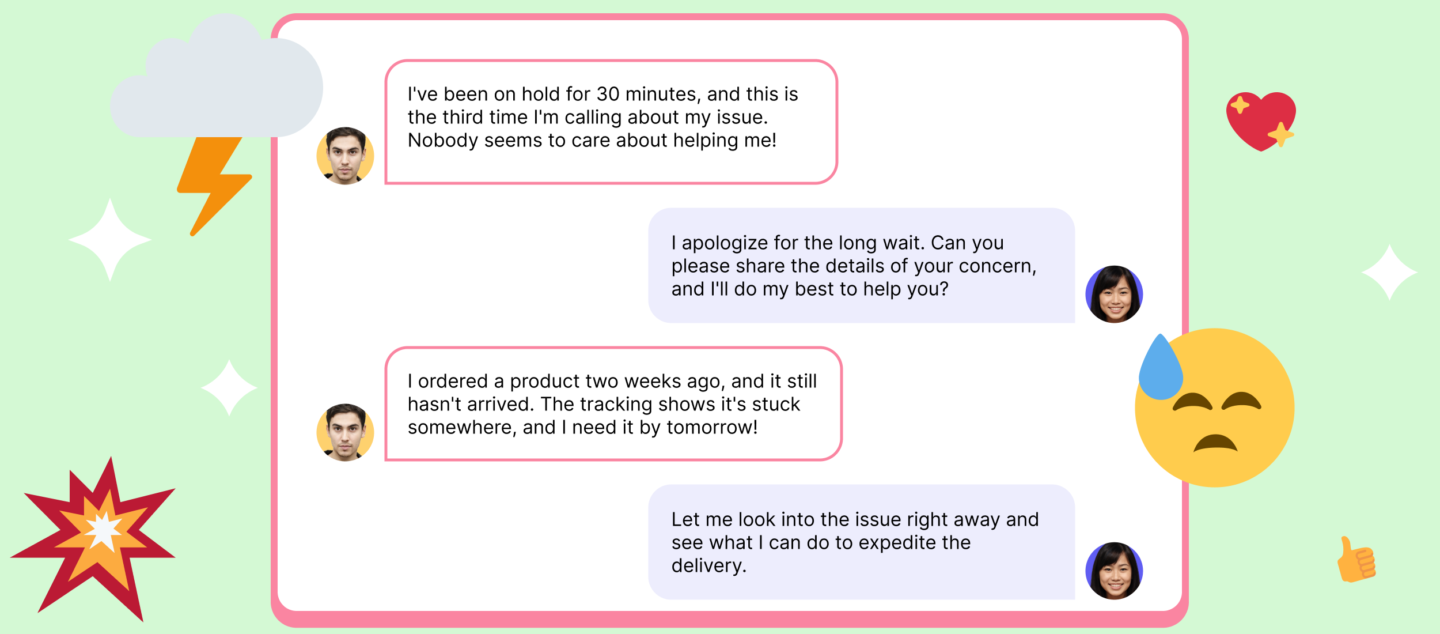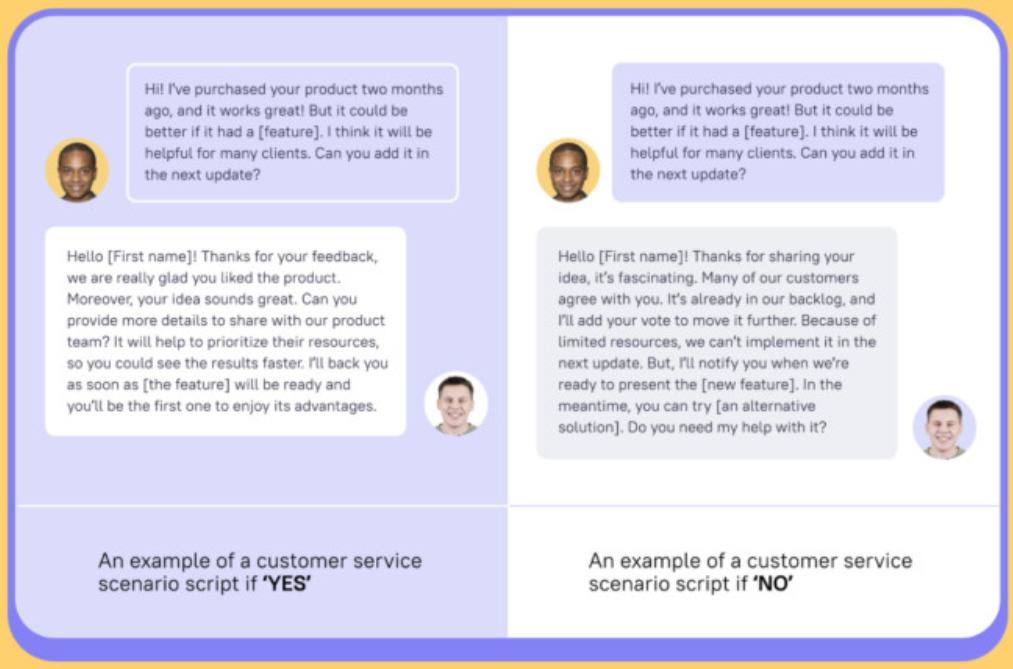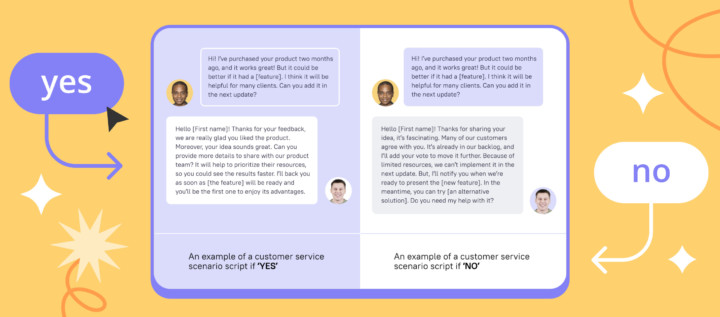Role playing templates for customer service

Role playing in customer service refers to a training technique in which employees act out various scenarios they may encounter while interacting with customers. This method enables customer service representatives to practice their skills, develop effective communication strategies, and learn to handle challenging situations in a controlled environment.
So, let’s start!
In this article, we’ll explain why role playing is vital for customer service/support and provide examples of situations to train your team.
Why role playing is a must for your team
In case you’re still unsure if role-playing is worth your team’s time, read this. After implementing regular role-paying meetings, Dashly customer support managers admitted the next benefits 👇
- Enhanced communication skills. Participants can practice active listening, empathetic responses, and assertiveness while engaging in simulated customer interactions.
- Confidence. By experiencing various scenarios, customer service representatives gain confidence in handling various customer interactions, from routine inquiries to challenging situations.
- Problem-solving skills. Role-playing allows employees to practice identifying customer needs, analyzing issues, and developing appropriate solutions in real-time.
- Empathy. By placing themselves in the customer’s shoes, employees can better understand customer emotions and perspectives, allowing them to provide more empathetic and personalized service.
- Immediate feedback. During role-playing exercises, trainers or peers can provide immediate feedback on performance, allowing participants to learn from their mistakes and improve their skills.
- Teamwork and collaboration. Role-playing can promote teamwork by requiring participants to collaborate and support each other during simulated scenarios. This helps build a more cohesive and effective customer service team.
- Customized training. Role-playing scenarios can be tailored to address specific challenges or issues a company faces, making the training more relevant and valuable to employees.
Sounds excellent, heh? Time to practice customer service scenarios for role plays!
12 scenarios for customer service role playing
Below are some examples of role-playing scenarios in customer service, along with example scripts for each situation. Choose the one you like to start the conversation with and continue it intuitively.
Scenario 1: Handling an angry customer
Customer service angry customer role play script 👇
Customer: “I’ve been on hold for 30 minutes, and this is the third time I’m calling about my issue. Nobody seems to care about helping me!”
CSR: “I apologize for the long wait and any frustration you’ve experienced. I understand how important it is to resolve your issue quickly. Can you please share the details of your concern, and I’ll do my best to help you?”
Customer: “I ordered a product two weeks ago, and it still hasn’t arrived. The tracking shows it’s stuck somewhere, and I need it by tomorrow!”
CSR: “I’m sorry to hear that your order hasn’t arrived as expected. I can understand how disappointing and inconvenient that must be. Let me look into the issue right away and see what I can do to expedite the delivery.”
Scenario 2: Dealing with a customer requesting a refund for a non-refundable item
Customer: “I bought this item from your store, but it’s not what I expected. I’d like to return it and get a refund.”
Customer service role: “I’m sorry to hear that the item didn’t meet your expectations. Can you please provide me with some information about the product, including the purchase date and order number?”
Customer: “Sure, here’s the information. I bought it two weeks ago, and the order number is 12345.”
Customer service role: “Thank you for providing that information. I see that the item you purchased is marked as non-refundable in our system. However, I understand your concerns, and I’d like to see if there’s an alternative solution we can offer. Would you be open to a store credit or an exchange for a different product?”
Scenario 3: Assisting a customer with a technical issue
Customer: “I’m having trouble setting up my new device. I’ve tried everything mentioned in the manual, but it still won’t work. Can you help me?”
CSR: “I’m sorry to hear that you’re experiencing difficulties with your new device. I’d be happy to assist you. Can you please provide the device model and describe the issue you’re facing in more detail?”
Customer: “It’s the XYZ model, and I can’t connect it to my Wi-Fi network. I’ve tried resetting it, but it still won’t connect.”
CSR: “Thank you for providing that information. Let’s go through the troubleshooting process together step by step. First, please ensure that your device is within range of your Wi-Fi router and that your Wi-Fi network is functioning properly?”
Build better customers service and alleviate your agents’ workload with Dashly AI
Scenario 4: Responding to a customer who received the wrong item
Customer service customer complaint role play script 👇
Customer: “I just received my order, and it’s not what I purchased. I ordered a blue shirt, but I got a red one instead. What should I do?”
CSR: “I apologise for the inconvenience and confusion caused by this mix-up. We’d like to correct this issue for you as soon as possible. Can you please provide your order number and the details of the item you received?”
Customer: “My order number is 67890, and I received a red shirt in size medium.”
CSR: “Thank you for providing that information. I’ve confirmed that the item you received is incorrect. We’ll arrange for a return label to be sent to you so you can return the incorrect item at no cost to you. Additionally, we’ll expedite the shipment of the correct item to ensure you receive it as soon as possible. I apologize once again for the inconvenience and appreciate your understanding.”
Scenario 5: Responding to a customer who is unhappy with the service received
Customer: “I’m extremely unhappy with the service I received. Your representative was unprofessional, and my issue wasn’t resolved. What are you going to do about it?”
CSR: “I’m sorry to hear that you had a negative experience with our service. We take customer feedback very seriously, and I’d like to help you resolve the issue. Can you please provide me with more information about the situation, including the name of the representative you spoke with and the details of the issue you were trying to resolve?”
Customer: “The representative’s name was John, and I was trying to get a refund for a defective product. He was unhelpful and seemed disinterested in my issue.”
CSR: “Thank you for providing that information. I’m sorry to hear that John wasn’t able to resolve your issue and that you felt unheard. I’m escalating this to our customer service manager, who will review your case and work with you to find a resolution that meets your needs. We appreciate your feedback and will do everything we can to make things right.”
Scenario 6: Dealing with a customer who is asking for a discount or special offer
Customer: “I’m interested in purchasing this product, but I see that the price is higher than I expected. Can you offer me a discount or a special deal?”
CSR: “Thank you for your interest in our product. While we don’t currently have any discounts or special offers available, I’d be happy to provide you with more information about the product and its features. May I ask if you’ve compared our pricing with other vendors in the market?”
Customer: “Yes, I’ve looked at several other vendors, and your price is still higher than most.”
CSR: “I understand. We take pride in offering high-quality products and services at a competitive prices. However, we appreciate your feedback and want to ensure you’re satisfied with your purchase. I can offer you free shipping on this order, which should help reduce the overall cost. Does that work for you?”
Continue role-playing the conversation, focusing on negotiation skills, clear communication, and finding a mutually beneficial solution.
Reduce your team’s workload and free your agents to address high-value tasks and complex customer issues with Dashly AI chatbot
Scenario 7: Responding to a customer who has experienced a billing error
Customer: “I just received my bill, and it’s much higher than it should be. There seems to be an error in the charges. Can you help me?”
CSR: “I’m sorry to hear that you’ve experienced a billing error. We take these issues very seriously and want to help you resolve this as quickly as possible. Can you please provide me with more information about the charges that appear to be incorrect?”
Customer: “Yes, there’s a charge for a service I never requested, which is much higher than advertised. I’m very concerned about this.”
CSR: “Thank you for providing that information. I can understand why you’re concerned, and I apologize for any confusion caused by this error. Let me investigate this issue and work with our billing department to resolve it. In the meantime, I’ll ensure your account is not charged for this service. I’ll follow up with you once I have more information.”
Scenario 8: Dealing with a customer who has encountered technical difficulties with a product
Customer: “I’ve been trying to use your product, but it’s not working as expected. There seems to be a technical issue. Can you help me fix it?”
CSR: “I’m sorry to hear that you’ve encountered technical difficulties with our product. I’d be happy to assist you. Can you please provide me with more information about the issue you’re experiencing?”
Customer: “Whenever I try to use the product, it freezes and crashes. I’ve tried restarting it, but the issue persists.”
CSR: “Thank you for providing that information. Let’s go through the troubleshooting process together step by step. First, can you please confirm that your device meets the system requirements for our product?”
Scale your customer service with the power of generative AI, paired with your knowledge base and scripts. Sign up to see how this technology saves your agents time and increases customer loyalty
Scenario 9: Dealing with a customer who has a product complaint
This is the help desk communication template for training social skills role play scripts 👇
Customer: “I purchased this product, but it’s not working as expected. It’s defective. What should I do?”
CSR: “I’m sorry to hear you’re experiencing issues with our product. We stand by the quality of our products and want to ensure you’re satisfied with your purchase. Can you please provide me with more information about the issue you’re facing?”
Customer: “The product doesn’t turn on, even after I’ve replaced the batteries. I’ve tried everything, and it still won’t work.”
CSR: “Thank you for providing that information. It sounds like you’ve encountered a defective product. I apologize for any inconvenience caused. We’ll arrange for a return label to be sent so you can return the product at no cost. Additionally, we’ll expedite the shipment of a replacement product to ensure you receive it as soon as possible. I appreciate your patience and understanding.”
Scenario 10: Responding to a customer who has a question about a product
Sample script for customer service role play 👇
Customer: “I’m interested in purchasing this product, but I have a question about its features. Can you help me?”
CSR: “Certainly! I’d be happy to provide you with more information about our product. Can you please share the details of your question?”
Customer: “I’m wondering if the product is compatible with my device. I have an older model, and I want to make sure that it will work before I make a purchase.”
CSR: “Thank you for your question. The product is compatible with a wide range of devices, including older models. However, to ensure that it will work with your specific device, I’d be happy to look up the compatibility requirements for you. Can you please provide me with the device model and any other relevant details?”
Scenario 11: Dealing with a customer who has a shipping issue
Here is an example of customer care activities scenario for such a situation 👇
Customer: “I received my order, but it arrived damaged. The packaging was torn, and the product is unusable. What should I do?”
CSR: “I’m sorry to hear that your order arrived damaged. We take care to ensure that our products are properly packaged and shipped, and I apologize for any damage caused in transit. Let me look up your order details and arrange for a return label to be sent to you. We’ll also expedite the shipment of a replacement product to ensure you receive it as soon as possible. I appreciate your understanding and patience.”
Continue role-playing the conversation, focusing on empathy, swift problem resolution, and proactive communication.
Scenario 12: Responding to a customer who has a general question about the company
Here is an example of the role playing chat 👇
Customer: “I have a question about your company. What are your hours of operation?”
CSR: “Thank you for your question. Our hours of operation are Monday through Friday from 9 AM to 5 PM Eastern Time. However, we have a 24/7 customer service line that you can contact at any time for assistance. Is there anything else I can help you with?”
Customer: “No, that’s all. Thank you for your help.”
CSR: “You’re welcome! If you have any other questions or concerns, please don’t hesitate to reach out to us. Have a great day!”
Continue role-playing the conversation, focusing on clear communication and helpfulness.
These role-playing scripts can be adapted to fit various customer service scenarios, enabling employees to practice their skills and improve their ability to handle diverse customer interactions effectively.
Save your team time by delegating clients FAQs to Dashly AI chatbot. He can easily answer even difficult questions based on your knowledge base info
20 Role playing customer service best practices
Excited to start implementing some of customer service role play ideas? Here are 20 role-playing customer service best practices that can help employees provide excellent customer service:
- Listen carefully to customers to understand their needs and concerns.
- Show empathy towards customers to build a positive rapport with them.
- Be patient with customers, even if they are frustrated or angry.
- Use clear and concise language to avoid misunderstandings.
- Use effective problem-solving techniques to help customers resolve their issues.
- Strive to resolve customer issues as quickly as possible to minimize inconvenience.
- Follow up with customers to ensure that their issues have been resolved satisfactorily.
- Advocate for the customer to ensure that their needs are met.
- Be confident in your ability to resolve customer issues and provide excellent service.
- Show respect towards customers at all times, even if you disagree with their viewpoint.
- Maintain a professional demeanor at all times, even if the customer is upset or angry.
- Be knowledgeable about the products and services offered by the company.
- Maintain a positive attitude, even when dealing with difficult customers.
- Prioritize tasks and manage time effectively to maximize productivity.
- Be flexible and adaptable in response to changing customer needs and circumstances.
- Keep customers informed of any updates or changes regarding their issues.
- Tailor interactions with customers to their individual needs and preferences.
- Be sensitive to cultural differences when communicating with customers.
- Use positive language to create a more positive customer experience.
- Continuously learn and improve your skills and knowledge to provide better customer service.
By incorporating these best practices into customer service interactions, employees can create a positive and memorable customer experience, increasing customer satisfaction and loyalty.
Download our playbook with 15 tricky customer service scenarios for role playing 👇 Role playing customer service will help both new and experienced agents to deal with complicated queries faster and more effectively.
Thanks! Now check your inbox

FAQ on
Customer service role play is an interactive exercise where employees practice customer service role play scenarios examples, allowing them to enhance their problem-solving and communication skills in a controlled, simulated environment.
What role does empathy play in customer service? It’s a fundamental element, enabling agents to genuinely understand and share customer emotions, nurturing trust and improving the quality of service delivered.
1. In a role play interview for customer service, how would you deal with an irate customer?
2. Demonstrate how to upsell a product during a service call in a role play interview.
3. Show how you would gather information from a customer who is vague about their issue in a role play interview.
4. Roleplay how to respond to a customer refusing to follow troubleshooting steps in a customer service interview.
As the Chief of Support at Dashly, I’ve frequently guided our team through empathetic customer care incidents. A memorable case involved a customer stressed over a tight integration deadline. We listened, provided reassurance, and expedited support to meet their timeline. This empathic response not only solved the issue but also deepened the customer’s trust in our commitment to their success.
The best roles for roleplay in customer service are those that reflect common customer interactions such as a concerned customer seeking a product return, a confused customer needing clarification on a service, or an upset customer reacting to a service outage. Utilizing roleplay templates can provide a structured approach to simulate these realistic scenarios, facilitating effective training and skill-building for customer service representatives.
Customer service role play scenarios are structured exercises that mimic real-life challenges faced by support personnel. Examples include addressing a complaint, solving a technical issue, or providing product information. To help standardize and streamline these exercises, a customer service script role play can be used as a guideline. For those looking to enhance their scenario planning, it’s possible to engage to download templates in a PDF format, such as customer service role play scripts PDF, which can be found in our article.
Sure, in a customer service role play interview, you basically get to act out how you’d handle tough customer situations on the job. You’ll be thrown some customer service role play interview questions that test your problem-solving and people skills. It’s like a quick, improv scene where you show off how cool and collected you can stay while sorting out customer issues.
When it comes to sharpening your team’s skills, some of the best customer service exercises include:
Role-Playing: Staff take turns acting as both the customer and the service rep to tackle typical service scenarios.
Active Listening: Employees practice fully concentrating on, understanding, responding to, and remembering what a customer says.
Empathy Building: Activities where team members share personal customer service experiences to nurture understanding and compassion.
Communication Improvement: Exercises focused on enhancing both verbal and non-verbal communication skills, crucial for clear customer interactions.
These examples are designed to boost the overall effectiveness and quality of your customer service team.





